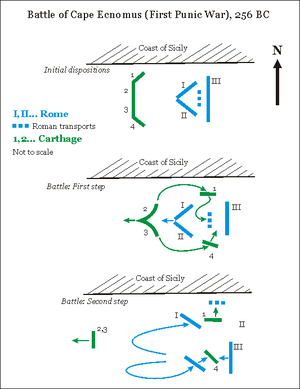Battle of Cape Ecnomus
| Battle of Cape Ecnomus | |||||||
|---|---|---|---|---|---|---|---|
| Part of the First Punic War | |||||||
| |||||||
| Belligerents | |||||||
| Roman Republic | Carthage | ||||||
| Commanders and leaders | |||||||
|
Marcus Atilius Regulus Lucius Manlius Vulso Longus |
Hamilcar Hanno | ||||||
| Strength | |||||||
|
About 330 ships Approx. 140,000 rowers and marines |
About 350 ships In excess of 150,000 rowers and marines[1] | ||||||
| Casualties and losses | |||||||
|
24 ships sunk Approx. 10,000 men killed |
30 ships sunk 65 ships captured Approx. 30,000-40,000 men killed or captured | ||||||
The Battle of Cape Ecnomus or Eknomos (Ancient Greek: Ἔκνομος) (256 BC) was a naval battle, fought off Cape Ecnomus (modern day Poggio di Sant'Angelo, Licata, Sicily), between the fleets of Carthage and the Roman Republic, during the First Punic War. Due to the number of ships and crews involved (about 300 rowers and 120 combat troops per ship), this battle was one of the largest naval battles of the ancient Mediterranean world, and is a candidate for the largest naval battle in history.
Prelude
Following the conquest of Agrigentum, the Roman Republic decided to build a fleet to threaten Carthage's supremacy in the Mediterranean Sea. Rome's initial disadvantage in experience was compensated for by the use of the corvus in the ships' prows. The resulting series of Roman victories in naval battles such as Mylae, inspired an attempt to invade the Carthaginian lands in North Africa.
Such an operation demanded an enormous number of ships to transport the legions and their equipment to Africa. To complicate the logistical problem, Carthage's fleet was patrolling the coasts of Sicily, which forced Rome to transport its army in military vessels like triremes and quinqueremes, which had little space for cargo. Therefore, Rome built a large fleet, of about 200 ships, to make the crossing of the Mediterranean with safety. The two consuls for the year, Marcus Atilius Regulus and Lucius Manlius Vulso Longus, were given command of the fleet. But the Carthaginians were not going to let this threat pass unchallenged and launched an equally large fleet to intercept the Romans, commanded by Hanno the Great and Hamilcar the later victor of Drepanum (not to be confused with Hamilcar Barca).
Battle

By this time, Roman naval tactics had improved. The fleet advanced along the Sicilian coast in battle formation, with the military ships deployed in three squadrons (see figure). Squadrons I and II, commanded by the consuls, led the way arrayed in a wedge. The bulk of the transport ships were right behind them and the third squadron protected the rear. The Carthaginians expected them and the two fleets met in the southern coast of Sicily off Mount Ecnomus. Carthage's fleet was disposed in the traditional long line, with the centre commanded by Hamilcar. The right flank commanded by the Hanno defeated in Agrigentum was slightly advanced.
Facing the foe, the two Roman leading squadrons advanced on the Carthaginian centre. Admiral Hamilcar then faked a retreat to allow the creation of a gap between the Roman vanguard and the transport ships that were his main target. Following this manoeuvre, both Carthaginian flanks advanced on the ships left behind, attacking from the side to avoid the effect of the corvus boarding mechanism. The transports were forced against the Sicilian coast and the reinforcements forced to enter the battle to face Hanno's attack.
The Carthaginian centre was defeated after a long fight and escaped the battle scene. Then the two leading Roman squadrons turned to relieve the situation in the rear. Consul Vulso's first squadron pursued the Carthaginian left, which was pushing the transports to disaster, and Regulus' ships, with the third squadron, launched an attack against Hanno. Without the support of the rest of their fleet, the Carthaginians were heavily defeated. As a consequence of this battle, about half of the Carthaginian fleet was captured or sunk.
Aftermath
Following the battle, the Romans landed in Sicily for repairs and to rest the crews. The prows of the captured Carthaginian ships were sent to Rome to adorn the rostra of the Forum, according to the tradition initiated at Mylae. Not long afterwards, the Roman army landed in Africa and began its punitive expedition against Carthage led by Atilius Regulus. The following battles of the First Punic War were therefore fought on Carthaginian soil, with victories ascribed to both sides.
Citations
References
- Polybius, I.25-29
- Adrian Goldsworthy, The Fall of Carthage (Cassel)
- W. L. Rodgers, Greek and Roman Naval Warfare (Naval Institute Press, 1937) pp. 278–291
External links
Coordinates: 37°06′00″N 13°56′00″E / 37.1000°N 13.9333°E
